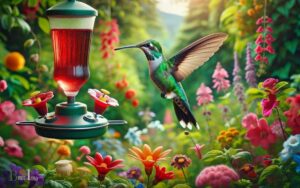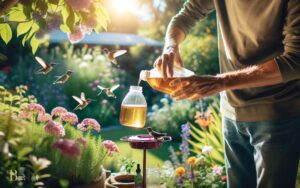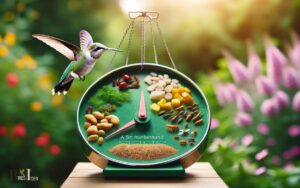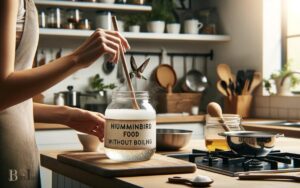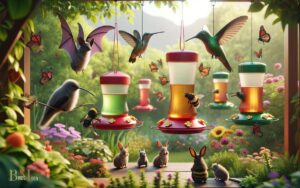Is Commercial Hummingbird Food Safe? Discover!
Commercial hummingbird food can be safe for hummingbirds if it is free from harmful additives and artificial colors.
However, it is crucial to choose products carefully and opt for those specifically formulated without these unnecessary ingredients.
Many bird enthusiasts recommend using homemade nectar solutions as a safer alternative to commercial products.
Example: A safe commercial hummingbird food should list only sugar and water as ingredients and should not contain any red dye or additional flavorings.
Ensure the well-being of hummingbirds by choosing or making food that mimics their natural diet, free from artificial ingredients.
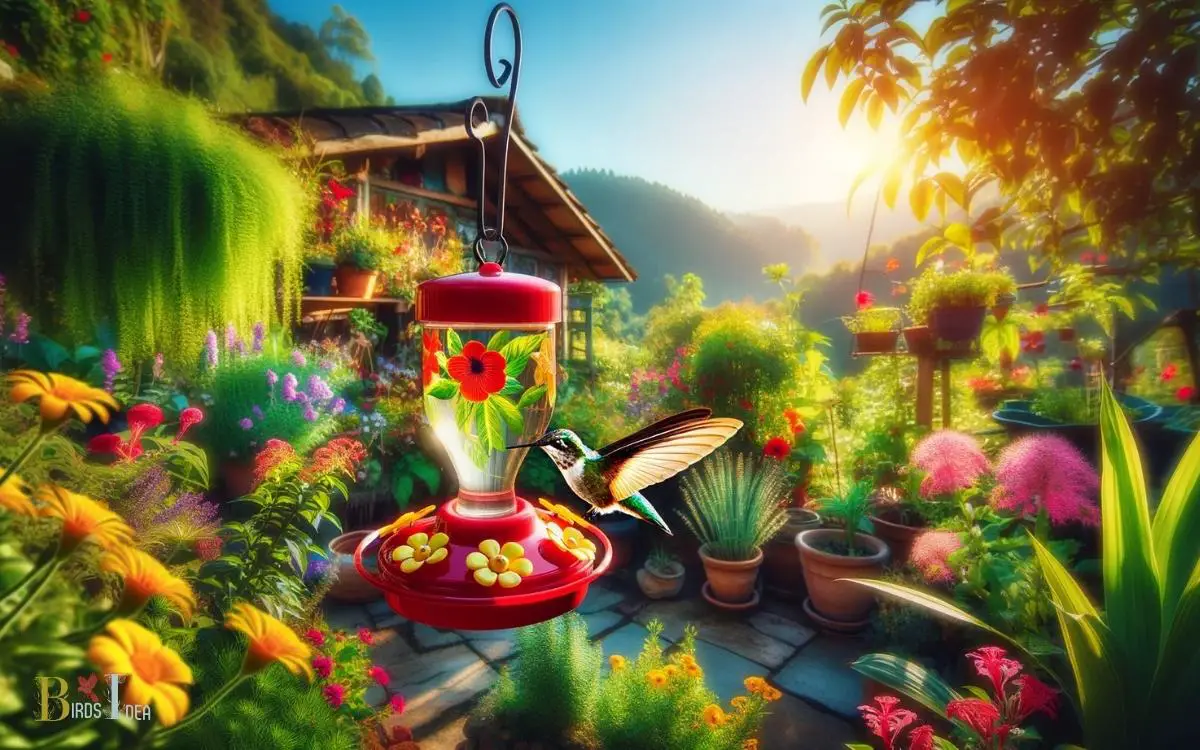
Key Takeaway
Potential Risks of Commercial Hummingbird Food
The potential risks of commercial hummingbird food include the use of artificial dyes and preservatives.
Artificial dyes such as Red Dye 40 and preservatives like potassium sorbate and sodium benzoate are commonly found in commercial hummingbird food.
These additives may pose health risks to hummingbirds, potentially causing allergic reactions, behavioral changes, and long-term health issues.
Furthermore, artificial dyes do not provide any nutritional benefits to the birds and may be harmful to their delicate digestive systems.
As individuals dedicated to serving the needs of these beautiful creatures, it is crucial to prioritize their well-being by offering them natural and safe food options.
Therefore, it is essential to carefully examine the ingredients of commercial hummingbird food and opt for natural alternatives to ensure the health and safety of these remarkable birds.
Common Ingredients in Commercial Hummingbird Food
Let’s now explore the common ingredients found in commercial hummingbird food. One key aspect to consider is the sugar and water ratio used in these products, as it directly affects the nutritional content and potential impact on hummingbirds.
The presence of artificial color additives in these foods is another important factor to examine in terms of its safety and potential effects on the birds.
Sugar and Water Ratio
When considering the safety of commercial hummingbird food, it is crucial to examine the sugar and water ratio, as these are common ingredients in such products.
Sugar and Water Ratio Considerations:
- Balanced Ratio: The ideal sugar and water ratio for hummingbird food is 1 part white, granulated sugar to 4 parts water. This closely mimics the natural sucrose levels found in flower nectar, providing a suitable energy source for the birds.
- Avoid Substitutes: Using alternative sweeteners like honey, brown sugar, or artificial sweeteners is not recommended, as they can be harmful to hummingbirds and may promote the growth of harmful microorganisms.
Maintaining the correct sugar and water ratio is essential in ensuring that the commercial hummingbird food provided is safe and beneficial for these delicate birds.
Artificial Color Additives
Artificial color additives are commonly included in commercial hummingbird food formulations.
These additives are used to make the nectar more visually appealing to humans, but they hold no nutritional value for the hummingbirds.
While these artificial colors do not pose a direct threat to the birds, there is concern about the potential long-term impact of these additives on their health.
Some studies suggest that certain artificial color additives may have negative effects on the overall well-being of hummingbirds.
Therefore, it’s important to carefully consider the use of artificial color additives in commercial hummingbird food and their potential impact on the birds’ health and behavior.
We will delve into the impact of artificial colors and additives, exploring the potential implications for our tiny feathered friends.
Impact of Artificial Colors and Additives
Although commercial hummingbird food may contain artificial colors and additives, it is important to consider their potential impact on the health of these delicate birds.
Potential Negative Impacts
- Artificial colors and additives may contain chemicals that are harmful to hummingbirds.
- Consumption of artificial ingredients could disrupt the natural diet and behavior of hummingbirds, affecting their overall well-being.
It is crucial to prioritize the health and safety of hummingbirds when offering commercial food.
Opting for natural and organic options or preparing homemade nectar without artificial additives can help ensure the well-being of these tiny birds.
By being mindful of the ingredients in hummingbird food, we can contribute to their thriving and contribute to their enjoyment for those who desire serving these remarkable creatures.
Considerations for Hummingbird Health
When considering the health of hummingbirds, it’s crucial to take into account the impact of sugar concentration in commercial hummingbird food, potential concerns associated with artificial dyes, and the effects of preservatives.
These factors play a significant role in the overall well-being and health of these delicate birds, making it essential to carefully evaluate the products used to attract and nourish them.
Understanding how these considerations can affect hummingbird health is integral to making informed decisions about the food provided to these fascinating creatures.
Sugar Concentration Impact
An optimal sugar concentration is crucial for maintaining the health and well-being of hummingbirds.
When preparing homemade hummingbird food or selecting a commercial nectar, it’s essential to consider the sugar concentration and its impact on these delicate creatures.
Here are some important considerations for sugar concentration:
Ideal Sugar Concentration
Aim for a solution consisting of 20-25% sucrose to closely mimic the nectar found in flowers, providing the necessary energy for hummingbirds.
Health Implications
Higher concentrations can lead to dehydration and kidney issues, while lower concentrations may not provide sufficient energy for these high-metabolism birds.
Keeping the sugar concentration within the recommended range ensures that hummingbirds receive the necessary nutrition without causing harm to their health.
Preservative Effects on Hummingbirds
As we consider the health implications of commercial hummingbird food, it is important to examine the potential effects of preservatives on hummingbirds.
Negative Impact on Gut Flora
Preservatives in commercial hummingbird food may disrupt the natural gut flora of hummingbirds, leading to digestive issues and potential health concerns.
Long-Term Health Effects
Prolonged consumption of preservatives could have unknown long-term effects on the overall health and well-being of hummingbirds.
Preservatives in commercial hummingbird food raise concerns about their impact on hummingbird health. Understanding the potential risks associated with these additives is crucial in making informed decisions about the food provided to these delicate creatures.
Now, let’s explore alternatives to commercial hummingbird food.
Is Songbird Essentials Clear Hummingbird Food Safe to Use?
Is Songbird Essentials Clear Hummingbird Food safe to use? Many hummingbird enthusiasts wonder if this particular brand of clear hummingbird food is the right choice for their feathered friends. Ensuring the safety of our hummingbirds is crucial, so it’s important to research the ingredients and quality of any clear hummingbird food before using it in your feeders.
Alternatives to Commercial Hummingbird Food
The use of natural nectar as an alternative to commercial hummingbird food is widely recommended by experts in the field.
Natural nectar closely mimics the composition of flowers, providing essential nutrients for hummingbirds without any artificial additives or preservatives.
To prepare natural nectar, simply mix one part white granulated sugar with four parts water. Boil the water to dissolve the sugar, then let it cool before filling the hummingbird feeder.
It’s important to avoid using honey, artificial sweeteners, or red food coloring, as these can be harmful to hummingbirds.
By using natural nectar, you can ensure that the hummingbirds visiting your garden are getting a safe and healthy source of food.
Transitioning into the subsequent section about ‘tips for making homemade hummingbird food’, it’s essential to understand the proper techniques and ingredients for creating a nourishing food source for these delightful birds.
Conclusion
Commercial hummingbird food may pose potential risks to the health of hummingbirds due to the use of artificial colors and additives.
It is important to consider alternatives such as making homemade hummingbird food using natural ingredients.
By doing so, we can ensure the well-being of these delicate creatures and provide them with a nourishing and safe source of sustenance.

